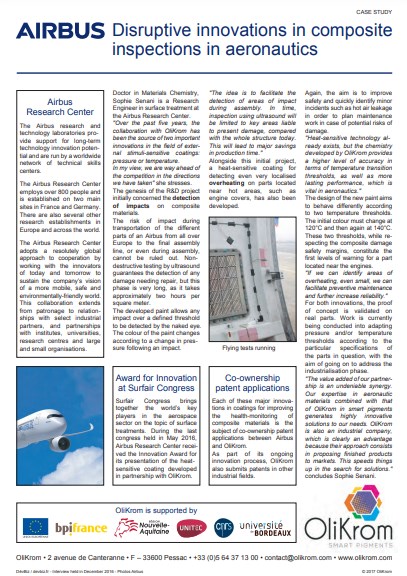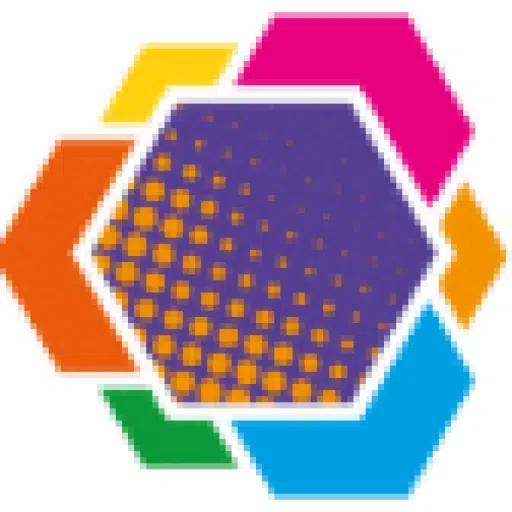Airbus OliKrom: Disruptive innovations in aeronautical composite inspection
Sophie Senani has a PhD in Materials Chemistry and is a Research Engineer in surface treatment at the Airbus Research Center.
"For nearly five years, the collaboration with OliKrom has been the source of two significant innovations in the field of coatings sensitive to an external stimulus: pressure or temperature. From my point of view, we are far ahead of the competition in the directions we have chosen," she says.
The genesis of the R&D project then concerns impact detection on composite materials. During the transport of the various parts of an Airbus from all over Europe to the final assembly line, the risk of an impact during transport or even during assembly cannot be excluded. Non-destructive testing by ultrasound guarantees the identification of any damage for repair, but this phase is very long, about two hours per square meter. The developed paint allows the naked eye to identify any impact above a certain threshold. The color of the paint changes under the effect of a pressure variation following an impact.
"The idea is to be able to facilitate the detection of impact zones during assembly. Eventually, ultrasonic inspection would be limited only to useful areas, likely to present damage, as opposed to the entire structure today, so the time savings in production will be considerable."
In parallel to this initial project, the development of a heat-sensitive coating for the detection of even very localized overheating on a part close to hot zones, such as an engine cover, was carried out. Here too, the aim is to improve safety and to quickly identify a minor incident, such as a hot air leak, in order to anticipate maintenance action in the event of a possible risk of damage.
"The heat-sensitive technology already exists, but the chemistry developed by OliKrom provides greater precision of the temperature transition threshold and more resistant performance in terms of longevity, which is essential in aeronautics." The objective of the developed paint is to have an evolving behavior according to two temperature thresholds. The initial color must change at 120°C and again at 140°C. While respecting the safety margins for damage to composites, these two thresholds then constitute the first warning levels for an element close to the engines
"If we can identify even a small area of overheating, preventive maintenance is made easier and reliability is further enhanced." For these two innovations, the proof of concept has been validated on real parts and current work focuses on adapting the pressure and/or temperature thresholds in accordance with the specific specifications for the targeted parts, so that the industrialization phase can then be tackled.
"The added value of our partnership is an undeniable synergy. Our expertise in aeronautical materials combined with that of OliKrom in intelligent pigments leads to very innovative solutions for our needs. Moreover, OliKrom is an industrial company and this is clearly an advantage because their approach is to offer finished products on the market, which makes it possible to go faster in the search for solutions," concludes Sophie Senani.
Airbus Research Center
A global network of technical competence centers operates the Airbus research and technology laboratories that support the company's long-term technological innovation potential. Located at two main sites in France and Germany, the Airbus Research Center employs over 800 people. In addition, there are numerous research facilities in Europe as well as in the rest of the world. The Airbus Research Center takes a decidedly global approach to cooperation, working with the innovators of today and tomorrow to support the company's vision of a more mobile, safe and eco-efficient world. This collaboration ranges from sponsorship to partnerships with institutes, universities, research centers and organizations of all sizes, as well as relationships with selected industrial partners.
Innovation Award at the Surfair Congress
The Surfair Congress brings together the world's leading players in the aeronautics and space sectors on the topic of surface treatments. At the last edition held in May 2016, the Airbus Research Center received the Innovation Award for its presentation of the thermosensitive coating developed in partnership with OliKrom.
Jointly owned patent applications
Each of these two major innovations on these coatings for the health control of composite materials is the subject of patents filed in co-ownership between Airbus and OliKrom. As part of its ongoing innovation process, OliKrom also files patents in industrial fields other than aeronautics.


